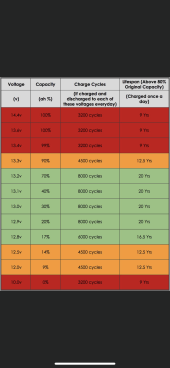Jack Rabbit Off Grid
Solar Enthusiast
- Joined
- Sep 6, 2021
- Messages
- 479
I have 6 Lifepower4 packs that are just over a year old now. After reading this I checked mine.
Battery 1 is closest to the inverter. I never flipped the negative buss bar. all 6 of my batteries show 100% SOH. If all 6 batteries don’t see an absorption cycle for a few weeks batteries 1 and 3 will lag behind On the SOC meters by one green dot.
Cycles
1.91
2.84
3.84
4.86
5.83
6.78
Battery 1 is closest to the inverter. I never flipped the negative buss bar. all 6 of my batteries show 100% SOH. If all 6 batteries don’t see an absorption cycle for a few weeks batteries 1 and 3 will lag behind On the SOC meters by one green dot.
Cycles
1.91
2.84
3.84
4.86
5.83
6.78



